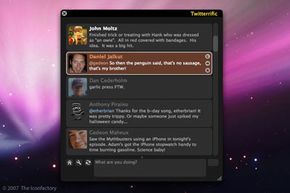Twitter's API
Twitter bases its application programming interface (API) off the RepresentationalStateTransfer (REST) architecture. REST architecture refers to a collection of network design principles that define resources and ways to address and access data. The architecture is a design philosophy, not a set of blueprints -- there's no single prescribed arrangement of computers, servers and cables. For Twitter, a REST architecture in part means that the service works with most Web syndication formats.
Web syndication is a pretty simple concept: An application gathers information from one source and sends it out to various destinations. There are a few syndication formats used on the Web. Twitter is compatible with two of them -- Really Simple Syndication (RSS) and Atom Syndication Format (Atom). Both formats retrieve data from one resource and send it to another.
Advertisement
Both Web syndication formats compatible with Twitter consist of a few lines of code. A Web page administrator can embed it into the code of his or her site. Visitors can subscribe to the syndication service -- called a feed -- and receive an update every time the administrator updates the Web page. Twitter uses this feature to allow members to post messages to a network of other Twitter members. In effect, Twitter members subscribe to other members' feeds.
By allowing third-party developers partial access to its API, Twitter allows them to create programs that incorporate Twitter's services. Obvious Corp's applications include desktop feed reader programs that let users post and retrieve messages on Twitter's network using a simple, independent interface. Current third-party applications include:
- OutTwit, a Windows application that allows users to access Twitter through the Outlook e-mail program
- Tweet Scan, which allows users to search public Twitter posts in real time using either a customized search engine or Firefox's search box
- Twessenger, which integrates with the Windows Live Messenger 8.1 instant messenger program
- Twittervision, which integrates a Twitter feed into Google Maps. You can watch public posts go live through a world map
- Flotzam, which integrates Twitter with Facebook, Flickr and blogs
- iTunes to Twitter, an application for Mac computers that broadcasts the title of the song currently playing in the user's iTunes to his or her network
That's just a small sample of Twitter applications available, and developers introduce new ones every day.
In the next section, we'll look at technical side of Twitter -- how it interfaces with mobile devices.
